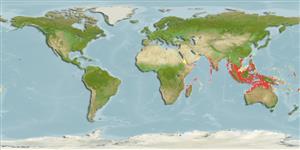Classification / Names
Common names | Synonyms | Catalog of Fishes (gen., sp.) | ITIS | CoL | WoRMS | Cloffa
Actinopterygii (ray-finned fishes) >
Pleuronectiformes (Flatfishes) >
Bothidae (Lefteye flounders)
Etymology: Engyprosopon: Greek, eggys = nearly + Greek,prosopon = a face (Ref. 45335); mozambiquensis: Named for Mozambique, country of its type locality.
Environment / Climate / Range
Ecology
Marine; demersal; depth range 8 - 90 m (Ref. 75635). Tropical, preferred ?
Indo-West Pacific: Mozanbique, N Madagascar, Myanmar, Nicobar Is., the Philippines.
Size / Weight / Age
Maturity: Lm ? range ? - ? cm
Max length : 6.5 cm SL (female)
Short description
Morphology | Morphometrics
Dorsal
soft rays
(total): 80-85;
Anal
soft rays: 59 - 64. This species is distinguished by the following set of characters: body depth 1.9-2.1 in SL (47.6-53.4% SL); head length (HL) 3.5-3.7 in SL (26.7-28.4%); on ocular side, upper jaw length 2.3-2.4 in HL (11.0-12.4% SL); interorbital widths in males 7.6-11.2 in HL (2.4-3.6% SL), females with 14.5-24.6 in HL (1.1-1.9% SL); ocular side, pectoral fins of females 1.3 in HL (20.7-21.5% SL); gill rakers 0 + 6.8; jaws with uniserial teeth; lateral line scales 46-50; dorsal-fin rays 80-85; anal-fin rays 59-64; pelvic rays 6 on both sides; large, dark spots on caudal fin absent (Ref. 75635).
Life cycle and mating behavior
Maturity | Reproduction | Spawning | Eggs | Fecundity | Larvae
Hensley, D.A., 2003. On the status of Rhombus cocosensis Bleeker, and description of a new species of Engyprosopon based on misidentification of this species (Pleuronectiformes: Bothidae). Copeia 2003(4):833-837. (Ref. 75635)
IUCN Red List Status (Ref. 115185)
CITES (Ref. 94142)
Not Evaluated
Threat to humans
Harmless
Human uses
More information
Common namesSynonymsMetabolismPredatorsEcotoxicologyReproductionMaturitySpawningFecundityEggsEgg development
Age/SizeGrowthLength-weightLength-lengthLength-frequenciesMorphometricsMorphologyLarvaeLarval dynamicsRecruitmentAbundance
ReferencesAquacultureAquaculture profileStrainsGeneticsAllele frequenciesHeritabilityDiseasesProcessingMass conversion
Tools
Special reports
Download XML
Internet sources
Estimates of some properties based on models
Phylogenetic diversity index (Ref.
82805): PD
50 = 0.5000 [Uniqueness, from 0.5 = low to 2.0 = high].
Bayesian length-weight: a=0.01023 (0.00442 - 0.02369), b=3.00 (2.81 - 3.19), in cm Total Length, based on LWR estimates for this (Sub)family-body shape (Ref.
93245).
Trophic Level (Ref.
69278): 3.4 ±0.4 se; Based on size and trophs of closest relatives
Resilience (Ref.
69278): High, minimum population doubling time less than 15 months (Preliminary K or Fecundity.).
Vulnerability (Ref.
59153): Low vulnerability (20 of 100) .
